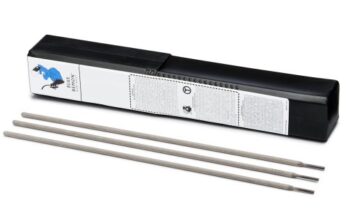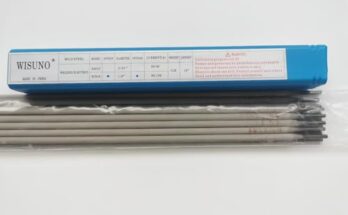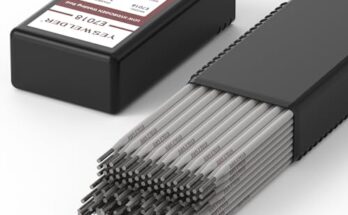Welding stainless steel can be tricky, but having the right tools makes all the difference. This guide dives deep into understanding 308 SS welding rods, explaining their properties, applications, and how to use them effectively. You’ll learn everything from choosing the right rod to mastering the welding technique.
What is a 308
SS Welding Rod?
A 308 SS welding rod is a consumable electrode used in the Gas Metal Arc Welding (GMAW), Gas Tungsten Arc Welding (GTAW), and Shielded Metal Arc Welding (SMAW) processes. It’s specifically designed for joining austenitic stainless steels, a category known for its corrosion resistance. The “308” designation refers to its specific chemical composition, primarily containing chromium and nickel, which are vital for the superior corrosion-resistant properties of the resulting weld. These rods are available in various diameters, lengths, and coatings depending on the application and welding process. Think of it like selecting the right type of glue – you wouldn’t use superglue to attach fabric, just as you wouldn’t use a 308 SS rod to weld mild steel. The wrong rod will lead to poor weld quality, potential failure, and frustration. Choosing the correct filler metal is paramount to achieving strong and durable welds. The specific alloying elements in the 308 SS rod ensure the weld metal closely matches the base metal in terms of composition and properties, preventing cracking and ensuring long-term durability. This is crucial for applications requiring high resistance to corrosion and oxidation.
Key Features and Benefits of 308 SS Welding Rods
308 SS welding rods are prized for their ability to produce strong, corrosion-resistant welds. Their high chromium and nickel content contributes to this superior corrosion resistance, making them ideal for applications exposed to harsh environments, such as marine environments, chemical processing plants, and food processing equipment. They are also known for their excellent weldability; the process is relatively straightforward compared to other stainless steel welding types, though proper technique is still crucial. The resulting weld is typically ductile and possesses good tensile strength, meaning it can withstand significant stress before breaking. This ductility is vital in applications where the weld may experience bending or flexing. One of the most noticeable benefits is the aesthetically pleasing finish; the welds produced using 308 SS rods are generally smoother and cleaner than those produced with other filler metals, leading to a more professional-looking final product. In my own experience, I’ve found that the ease of use and consistently good results make 308 SS rods a favorite among welders of various skill levels.
Choosing the Right 308 SS Welding Rod
Selecting the correct 308 SS welding rod involves considering several factors. First, the base metal composition; ensuring compatibility is crucial for a successful weld. The diameter of the rod will depend on the welding process used and the thickness of the base material. Thicker materials require larger diameter rods. The length of the rod is usually standard, but bulk purchasing might offer cost advantages. The type of coating, if applicable (SMAW process), also affects the weld. Some coatings provide better arc stability and improved penetration. For example, in shipbuilding, where corrosion is a major concern, the choice of 308 SS rod is dictated by the need for maximum corrosion resistance in a harsh saltwater environment. Similarly, in food processing, the choice is driven by the requirement of a sanitary weld that won’t contaminate the product. Consider the specific demands of the project before making your choice; understanding these specifics ensures the weld will meet the required performance standards.
Welding Processes Suitable for 308 SS Rods
Gas Metal Arc Welding (GMAW) with 308 SS
GMAW, often called MIG welding, is a popular method for joining 308 SS. It involves feeding a continuous wire electrode (the 308 SS rod) into a weld pool, with a shielding gas protecting the weld from atmospheric contamination. The shielding gas, usually argon or a mixture of argon and carbon dioxide, prevents oxidation and ensures a clean, smooth weld. GMAW with 308 SS offers excellent penetration and speed, making it ideal for high-volume production. However, mastering the technique requires practice, as the wire feed speed and voltage need precise adjustment. A common issue for beginners is improper wire feed speed which leads to poor fusion or excessive spatter. Consistent practice and a good understanding of the machine settings are key to achieving professional-quality results. I remember my first attempt at MIG welding 308 SS – it was a disaster! Too much spatter and uneven penetration. But after persistent practice, I learned to adjust the parameters to achieve a smooth, consistent bead.
Gas Tungsten Arc Welding (GTAW) with 308 SS
GTAW, often referred to as TIG welding, is a precise method providing excellent control over the weld pool. A non-consumable tungsten electrode creates an arc that melts the base metal and the 308 SS filler rod. This method is preferred for critical applications where high quality and precise control are necessary, such as welding thin materials or those requiring a visually appealing weld. The shielding gas, usually pure argon, safeguards the weld from atmospheric contamination. GTAW with 308 SS results in exceptionally clean welds, with minimal spatter and excellent penetration. The added precision, however, translates to a slower welding speed compared to GMAW. I’ve used GTAW extensively for intricate repairs on stainless steel components, valuing the superior control and the clean, aesthetically pleasing results. The ability to precisely control the heat input allows for accurate welding of different thicknesses and complex joints.
Shielded Metal Arc Welding (SMAW) with 308 SS
SMAW, also known as stick welding, uses a coated 308 SS electrode. The coating provides shielding gas and flux, which stabilizes the arc and cleans the weld. This method is more portable than GMAW or GTAW since it doesn’t require gas cylinders, making it a practical option for on-site welding. Although SMAW with 308 SS offers good penetration, it typically results in a less aesthetically pleasing weld compared to GTAW. The slag produced needs to be carefully removed after welding. The technique requires careful manipulation of the electrode to maintain a consistent arc and prevent excessive spatter. While I find SMAW a robust method for some applications, the resulting weld quality often isn’t as clean as with GTAW or even GMAW when used with 308 SS. The skill required to achieve a good weld is also higher than with MIG welding.
Applications of 308 SS Welding Rods
Industrial Applications
308 SS welding rods are extensively used in various industries where corrosion resistance is paramount. Chemical plants use them for constructing and repairing equipment that handles corrosive chemicals. The food processing industry relies on them to build hygienic and durable equipment that meets stringent sanitation standards. The pharmaceutical industry also uses 308 SS for similar reasons. In addition, their use in marine applications is extensive, due to their resistance to saltwater corrosion. Examples include the fabrication of ship hulls, piping systems, and other components exposed to sea water.
Automotive and Aerospace
Though less frequently used than other filler metals, 308 SS welds find their place in specific automotive and aerospace components where corrosion resistance is crucial. Exhaust systems, particularly those exposed to higher temperatures and corrosive gases, might utilize 308 SS welds. Specific aerospace components needing high-level corrosion resistance, such as certain fuel system components, might also involve 308 SS. The demands for lightweight and durable materials make this application less common, but in selected niches, the corrosion resistance outweighs other considerations.
Architectural and Construction
In architectural and construction projects, 308 SS welds provide long-lasting solutions for ornamental structures and components needing high corrosion resistance. Railings, cladding, and certain structural elements in coastal regions or chemically harsh environments benefit from the corrosion-resistant properties of the 308 SS weld. The aesthetic appeal of the smoother welds also adds to its desirability in architectural applications.
Safety Precautions When Using 308 SS Welding Rods
Personal Protective Equipment (PPE)
Always wear appropriate PPE when welding with 308 SS rods. This includes a welding helmet with appropriate shade lenses to protect your eyes from intense UV radiation and visible light, welding gloves to safeguard your hands from burns and spatter, protective clothing like a leather apron or jacket to cover your body, and sturdy work boots. Safety glasses are also necessary for eye protection, particularly when cleaning slag. Neglecting PPE can lead to serious injuries, including eye damage, burns, and respiratory problems.
Ventilation
Ensure adequate ventilation to remove harmful fumes and gases generated during the welding process. The fumes can cause respiratory problems and irritation. Welding in a well-ventilated area is crucial for the health and safety of the welder. A proper ventilation system, whether natural or mechanical, must be in place to mitigate the risk of inhaling harmful substances.
Fire Hazards
Welding can pose a fire risk, especially when working near flammable materials. Keep a fire extinguisher nearby and take precautions to protect flammable materials from sparks and spatter. Be mindful of the surrounding area, ensuring no flammable liquids or materials are within close proximity. If working outdoors, caution must be exercised with dry vegetation and materials that can easily ignite.
Comparing 308 SS Welding Rods to Other Stainless Steel Rods
308 vs. 316 SS Welding Rods
316 SS welding rods are similar to 308 SS, but contain molybdenum, increasing their corrosion resistance in chloride environments. 308 SS is generally less expensive, and is suitable for most stainless steel applications. 316 is the better choice when exposed to saltwater or aggressive chloride solutions. Choosing between the two depends entirely on the specific application’s requirements. The additional cost of 316 is often justified for critical applications.
308 vs. 304 SS Welding Rods
304 SS welding rods are also commonly used, but they have slightly lower corrosion resistance than 308 SS. 308 provides a better match for the base metal in most cases, providing a stronger and more corrosion-resistant weld. The choice again depends on the application’s specific demands. For general stainless steel applications, 308 typically provides superior results.
Factors Affecting the Quality of 308 SS Welds
Proper Welding Technique
Proper technique is paramount to achieve a high-quality weld. This includes maintaining a consistent arc length, proper travel speed, and correct electrode angle. Incorrect techniques lead to poor fusion, porosity, and reduced strength. Regular practice and training are vital to mastering the skills required.
Cleanliness of the Base Metal
Cleaning the base metal is crucial for good weld penetration and overall weld quality. Removing oil, grease, rust, and other contaminants from the surface before welding is essential. A clean surface ensures proper fusion between the base metal and the filler metal. Ignoring this vital step often leads to defects like porosity and cracking.
Preheating and Post-Welding Heat Treatment
Depending on the thickness of the base metal and the specific application, preheating and post-weld heat treatments might be necessary to prevent cracking and ensure optimal weld properties. These processes can improve the mechanical properties and reduce the risk of weld defects. Consulting the manufacturer’s guidelines for your specific 308 SS rod is advisable for determining if these steps are necessary.
Troubleshooting Common 308 SS Welding Problems
Porosity
Porosity in 308 SS welds is typically due to contamination of the base metal or inadequate shielding gas protection. Careful cleaning of the base metal and ensuring a sufficient flow of shielding gas can prevent this problem. Checking the gas flow rate and ensuring the torch nozzle is clean are critical steps.
Lack of Fusion
Lack of fusion can occur if the base metal is not properly cleaned or if the welding parameters (voltage, wire speed, travel speed) are not set correctly. Careful preparation of the base metal and adjusting the welding parameters as needed are key to addressing this issue.
Cracking
Cracking often results from improper welding technique, inadequate preheating, or the use of an inappropriate 308 SS rod for the base metal. Paying close attention to welding technique and preheating requirements is essential to prevent cracking.
Frequently Asked Questions
What is 308 SS welding rod best for?
308 SS welding rods are best suited for joining austenitic stainless steels, especially those with similar chemical compositions. They excel in applications requiring high corrosion resistance and good weld strength. Learn more about the various types of stainless steel and their welding requirements.
What is the difference between 308L and 308 stainless steel welding rods?
The “L” in 308L denotes a low-carbon version. 308L has a lower carbon content, reducing the susceptibility to sensitization and cracking during welding. It’s preferred for thicker sections or when post-weld heat treatment isn’t feasible. Learn more about the different grades of 308 stainless steel and their specific properties.
Can I use 308 SS welding rod on 304 stainless steel?
While you can use 308 SS on 304 stainless steel, it’s not the ideal choice. A better match would be a 304 stainless steel welding rod. However, for less demanding applications, 308 SS might suffice. Learn more about choosing the right welding rod based on the base metal.
What shielding gas should I use with 308 SS welding rods?
The choice of shielding gas depends on the welding process. For GMAW, a mixture of argon and carbon dioxide (e.g., 75/25 Argon/CO2) is commonly used. For GTAW, pure argon is typically used. The proper shielding gas is crucial for preventing weld contamination and ensuring a quality weld. Learn more about the different types of shielding gases and their applications.
What are the common problems encountered when welding with 308 SS welding rods?
Common problems include porosity, lack of fusion, and cracking. These are usually caused by improper welding technique, poor base metal preparation, or incorrect welding parameters. Learn more about troubleshooting common welding problems and how to prevent them.
How do I determine the correct size of 308 SS welding rod?
The correct size depends on the thickness of the base material and the welding process used. Thicker materials require larger diameter rods. Always refer to welding charts or manuals for specific recommendations. Learn more about proper sizing of welding rods and choosing the right diameter for various applications.
What safety precautions should I take when using 308 SS welding rods?
Safety precautions include wearing appropriate PPE (including a welding helmet, gloves, and protective clothing), ensuring adequate ventilation, and taking steps to prevent fire hazards. Always follow safety guidelines and regulations. Learn more about safety measures when performing any welding process.
Final Thoughts
Mastering the art of welding with 308 SS rods unlocks a world of possibilities for creating strong, durable, and corrosion-resistant joints in various applications. From understanding the different welding processes to selecting the right rod and mastering proper techniques, this comprehensive guide provides a solid foundation for both novice and experienced welders. By adhering to safety precautions and employing proper techniques, you can achieve high-quality welds that meet the demands of your specific projects. Remember to always prioritize safety and continually refine your skills to produce consistently excellent results. So, grab your welding gear, and start exploring the world of stainless steel welding!


